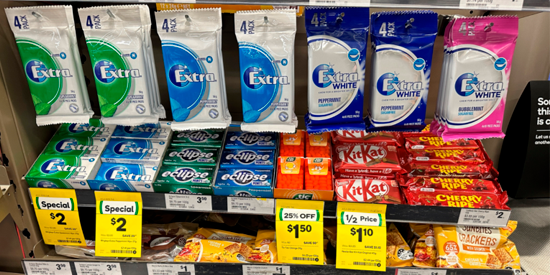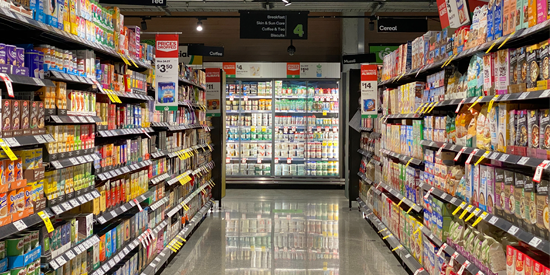Woolworths commits to healthier checkouts and end-of-aisle displays
Research news
This article originally appeared on the Re-Fresh website on Tuesday 4 July 2023. Access the original article.
Woolworths announced late last week that they’re committing to “healthier” checkouts and end-of-aisle displays. From a public health perspective, this sounds like big news, given the strong influence of supermarkets on what people buy.
Our research over the last decade has shown that changes to the way in which foods are marketed in Australian supermarkets are sorely needed. Our 2020 study conducted in the largest Australian supermarket chains (including Woolworths) showed that almost 80% of display space at checkouts was for unhealthy foods, such as chocolate, confectionery, sugary drinks and chips.
And we found a similar set-up in end-of-aisle displays, with 80% of food displays having at least one type of unhealthy product.
Unhealthy food environments such as these have been a key contributor to the unhealthy state of Australian diets, with only 7% of Australians eating in line with health recommendations.
What have Woolworths promised?
In a first for an Australian supermarket, Woolworths has announced commitments to make their displays at checkouts and end-of-aisles healthier.
At checkouts, their commitments include:
- No “kids confectionery”
- 80% of checkout shelf space to be dedicated to healthier options, defined as products having a Health Star Rating (HSR) of 3.5 stars or more
And for end-of-aisle displays, Woolworths has said that even though unhealthy foods will still be on display and ‘on special’ (price promoted), they will add healthier options to such displays. This includes displaying “a similar snacking option with a 3.5 HSR or above on display on a shelf on each promotional end”.
Will this make their supermarkets healthy places to shop?
Woolworths’ commitment to have healthier checkout displays is a substantial advance on the status quo. Evidence shows that anywhere from 20 to 70% of unhealthy food purchases in supermarkets are ‘impulse buys’ or unplanned purchases. By reducing the prominence of unhealthy products at checkouts, it is likely that impulse buys for these products will decrease at Woolworths. By removing “kids confectionery” from checkout displays, it is likely that “pester power” related to these products will also decrease.
Importantly, though, under Woolworths’ commitment, checkout displays will still not be completely healthy. Chocolates and confectionery will remain prominently displayed – just as long as they’re not deemed to be directly targeting children. Based on our previous research, many of the unhealthy products on display are likely to be ‘on special’ too. Research shows that price promotions dramatically increase sales of products in supermarkets.

Chocolates and confectionery likely to remain prominent in checkout displays a Woolworths, even after their new commitments have been implemented.
Regarding end-of-aisle displays, the proposed changes are less impressive. Woolworths are not proposing to change their existing marketing strategy of placing unhealthy foods that are heavily discounted on the ends of aisles. These tactics have been shown to be a particularly powerful driver of what people buy. For example, placing soft drink at the end-of-aisle has been shown to increase purchases of those products by over 50%.
And evaluations of the impact of price promotions on overall purchases show an increase of nearly 20% in particular product categories.
It remains to be seen whether Woolworths’ commitment to add a healthier alternative to existing unhealthy displays will improve the healthiness of what people buy. If the healthier options are not discounted in price to the same extent as the unhealthy alternatives, it seems unlikely to make much difference.
How do these changes compare to international best practice?
While Woolworths’ new commitment is commendable, it falls short of international best practice in this area. In the UK, all the major supermarket chains committed to completely remove confectionery from their checkouts many years ago. This was followed up by mandatory UK government regulations that ban the display of all unhealthy foods and drinks at checkouts (from 1 October 2022).
Efforts to improve the healthiness of checkouts and end-of-aisle displays form just one component of recommended actions for supermarkets to create shopping environments that support health and nutrition. Other recommendations include restricting price promotions on unhealthy products, avoiding promotional techniques that appeal to children (e.g., product packaging that features cartoon and animated characters) in relation to unhealthy foods, and setting overall targets for sales of healthy products.
A step in the right direction
It is encouraging to see Woolworths make commitments to improve the healthiness of their stores. From a public health perspective, it is hoped that the latest announcement is a step towards more ambitious commitments that will truly make Woolworths a healthy place to shop.
And even though Woolworths are the biggest selling supermarket in Australia, they are only one of several retailers. Large scale shifts towards healthier diets in Australia will require other major retailers to follow suit.
‘ Based on the UK experience, government regulation is likely to be needed to ensure industry-wide change that will transform population diets.’
The Australian government has committed to policy action in food retail environments as part of the National Obesity Strategy (2022-2032) and National Preventive Health Strategy (2021-2030). But, since the release of those strategies, there has been no indication of government plans to implement regulations regarding how supermarkets market products.
In the meantime, monitoring and evaluation of supermarket policies and practices, and their impact on purchases, will remain critical.
Professor Gary Sacks

- Professor of Public Health Policy and Co-Director of the Global Centre for Preventive Health and Nutrition (GLOBE) at Deakin University.
- NMHRC Emerging Leadership Fellow (2022-2026)
- Heart Foundation Future Leader Fellow (2019-2023).
- Co-author of several international reports on obesity prevention, including the Lancet Commission on Obesity, and several reports for the World Health Organization.
- 2017 Council of Academic Public Health Institutions Australia (CAPHIA), Team Research Award, with A/Prof Adrian Cameron
- Led the first-ever studies to benchmark progress on obesity prevention by Australian governments and food companies.
- Co-founded INFORMAS (International Network for Food and Obesity / non-communicable diseases Research, Monitoring and Action Support) - a global network (active in 60+ countries) for monitoring food environments.
- Profile on The Conversation
A/Professor Adrian Cameron

- Published widely in areas related to obesity and nutrition.
- Member of the International Society for Behavioural Nutrition and Physical Activity and Australian and New Zealand Obesity Society
- 2017 Council of Academic Public Health Institutions Australia (CAPHIA), Team Research Award, with Prof Gary Sacks
- 2016 VicHealth Award for Promoting Healthy Eating
- 2009 Victorian Government, Premiers Award for Health and Medical Research, commendation
- Section Editor (Epidemiology and Ethnicity) for BMC Obesity
- Editorial Board Member of the International Journal of Behavioural Nutrition and Physical Activity.
- Regular manuscript reviewer for numerous journals and a grant reviewer and grant review panel member for the NHMRC.
- Profile on The Conversation
Share this story

Key Fact
Evidence shows that anywhere from 20 to 70% of unhealthy food purchases in supermarkets are ‘impulse buys’ or unplanned purchases.
